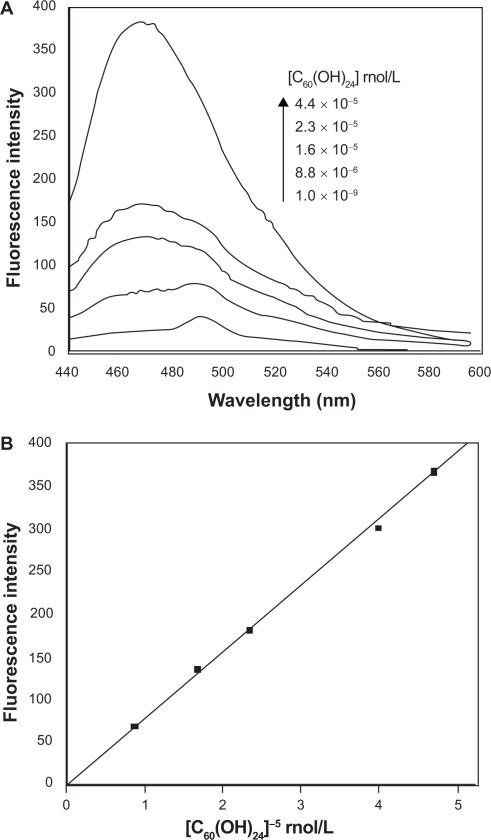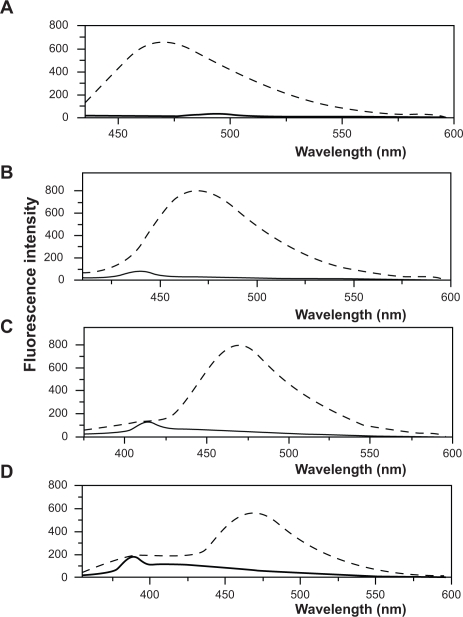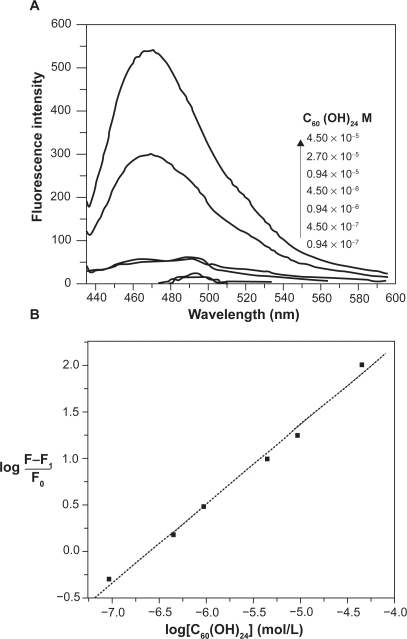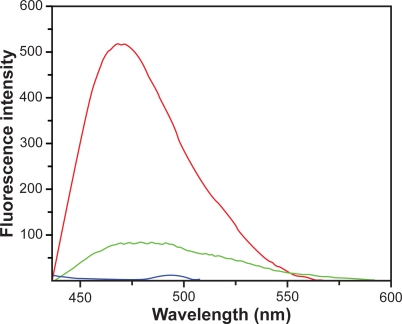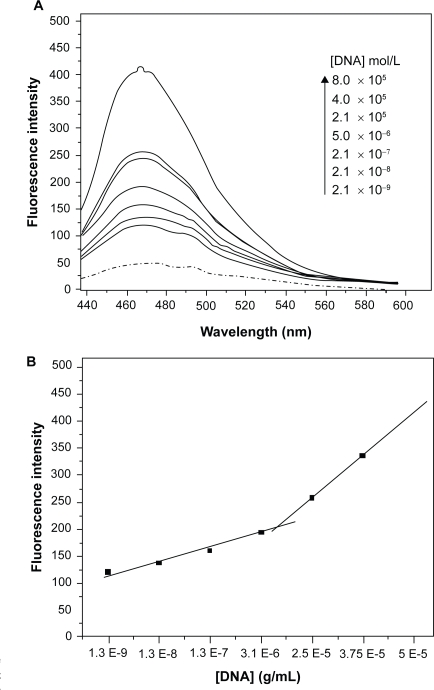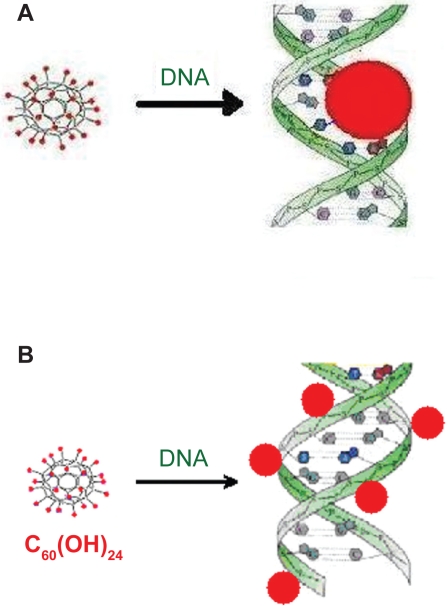Abstract
The first C60(OH)24-DNA complex and its fluorescence enhancement is reported. The enhanced fluorescence intensity of fullerenol C60(OH)24 is in proportion to the concentration of DNA in the range of 1 × 10−9 to 8 × 10−5 molL−1 and the detection limit was 1.3 ng mL−1. Fullerenol C60(OH)24 binds significantly to the phosphate backbone of native dsDNA and to base-pairs within the major groove of sodium salt of dsDNA.
Keywords: nanomedicine, fullerenol, DNA complexation, fluorescent probe
Introduction
Nanoscale materials seems to offer great opportunities for biomedical applications such as therapeutic and diagnostic tools.1–9 Biomedical applications under development include drug delivery systems targeted to the brain and cancer tissues, gene transfection, and intravascular nanosensor and nanorobotic devices for imaging and diagnosis.3,9
In this context, the biological activities of fullerene derivatives have attracted much attention in the past 25 years.10–17 As potent free-radical scavengers and antioxidants18–23 the water-soluble polyhydroxylated [C60]fullerenes, fullerenols, exhibit an exciting range of biological activities as glutamate receptor antagonists,24 antiproliferative,25–27 neuroprotective,28–31 and anticancer agents.32–37
Knowing the ways fullerenols interact with proteins and nucleotides is a prerequisite for understanding their biological effects at membrane penetration and the intracellular level, only two studies deal with their binding to proteins38,39 and their interaction with DNA has not been reported to date.
On the other hand, the solution-based assays and quantitative analysis of nucleic acids are critical in current biochemistry and biomedical science. Throughout the years, a number of fluorimetric methods for the determination of nucleic acids have been developed with ethidium bromide,40–42 lanthanide cations,43–45 ruthenium complexes,46–48 and asymmetric cyanine dyes as fluorescence probes.49–51
Despite the prominence of fullerenes in bionanotechnology, the exploration of their fluorescent properties in solution remains still at a very early age. Several studies have been devoted to dsDNA/single-walled carbon nanotube hybrid systems,52,53 but only very few deal with their fluorescent proprieties54,55 when dispersed in aqueous solution.
Herein, we are happy to report the first complexation of dsDNA with C60(OH)24 in aqueous media in the absence of a buffer in physiological pH-range.
Materials and methods
C60 (99.5+%) was purchased from MER Corp (Tuscon, AZ, USA). KOH (99.99%, semiconductor grade) was purchased from Sigma-Aldrich (St. Louis, MO, USA). DNA (low molecular weight, salmon sperm) was purchased from Fluka (St. Louis, MO, USA). All other reagents were purchased from Sigma-Aldrich.
Fluorescence spectroscopy was performed with a Perkin Elmer LS55 spectrometer Perkin Elmer, Wellesley, MA, USA). To prepare fluorescence samples, the only operation was the mixing of two solutions before fluorescence measurements. X-ray photoelectron spectroscopy (XPS) measurements were carried out using a Leybold LHS 10 spectrometer (Leybold, Cologne, Germany).
To the best of our knowledge, most of these fullerenols are not pure C60(OH)n, but a complex mixture of products. For instance, those synthesized through sulfuric/nitric acid,56 hydroboration,57 or nitronium chemistry58 afforded products with average composition of C60Ox(OH)y. The so-called fullerenols prepared by alkaline polyhydroxylation of C60 under phase transfer conditions59 are not simply C60(OH)x, but stable radical anions with the molecular formula, Na+n[C60Ox(OH)y]n−,60 and the fullerenol obtained by alkaline hydrolysis of C60Br24 is not C60(OH)24 as claimed by Bogdanovi and Dvordjevic,37,61 but C60(ONa)8(OH)16.62 In the light of this, many biomedical studies involving fullerenols species in the literature may need to be reconsidered. The pure fullerenol C60(OH)24 used in this study was prepared by a modified method of alkaline hydrolysis of C60Br24,62 followed by demetallation of the obtained C60(OK)8(OH)16 with a cation exchange resin and exhaustive purification by dialysis.
Representative procedure for synthesis of C60(OH)24
All experiments were performed with Schlenk techniques under argon and protected from light. According to the literature, before the synthesis of the polyhydroxylated fullerene, bromofullerene C60Br24 was synthesized first.62 In the synthesis of the C60(OH)24, to a sonicated (40 W, 15 min) suspension of C60Br24 (200 mg, 0.075 mmol) in de-aerated water (100 mL), fresh KOH (200 mg, 3.57 mmol) was added under argon protection and stirred for 10 days at room temperature. After the reaction was completed, the resulting dark-brown solution was passed to a centrifuge at 4000 rpm for 30 min and the supernatant was brought to dryness in a rotavapor apparatus at 40 °C. The dark-brown residue was dissolved in 50 mL of deionized water, stirred with ion exchange resin AMBERJET™ 1200[H] (Rohm and Haas Company, Philadelphia, PA, USA) (20 mL) for 8 h and subjected to dialysis (Spectra/Por® 1000 D; Spectrum Laboratories, Rancho Dominguez, CA, USA) for four days. Finally, the dialyzed solution was brought to dryness in a rotavapor apparatus at 60 °C and dried at 80 °C and 10−4 Torr for 24 h. The fullerenol thus obtained contained 24 hydroxyl groups as characterized by elemental analysis, Fourier transform infrared (FT-IR) spectroscopy, and XPS spectroscopic measurements.
Elemental analysis
Calculated for C60H24O24: C, 63.82; H, 2.12. Found: C, 63.66; H, 1.98. FTIR (KBr): ν max, 3436 (−OH), 1605 (C = C), 1430 (δ −OH), 1095, 1046 (ν C-OH), 1018, 994, 825, 877, 570, 530 cm−1.
XPS analysis
C1s components: % C = C (284.6 eV) 59.77 (clcd. 60); % C-OH: (285.8 eV) 39,76 (clcd. 40); O/C = 0.42 (clcd. 0.40).
Results and discussion
The fullerenol water solution, exhibited different maxima depending on the concentration (Figure 1a). In the range of 1.6 × 10−5 to 4.4 × 10−5 molL−1 one fluorescent maximum was observed at 469 nm, while two fluorescence maxima where found for lower concentrations located at 469 nm and 492 nm at λex = 420 nm.
Figure 1.
Fluorescence data of C60(OH)24 in aqueous media. A) Fluorescence emission spectra of C60(OH)24 after 5 min incubation in water, with excitation at 420 nm. B) Plot of fluorescence intensity versus [C60(OH)24], with excitation at 420 nm; average standard error, 3.76%.
These emission profiles of fullerenol at different concentrations provided the baseline for understanding perturbation upon interaction with dsDNA. As shown in Figure 1a, the most appropriate concentrations of fullerenol in water for fluorescence measurements at λex = 420 nm are within the range of 1.6 × 10−5 to 4.4 × 10−5 molL−1 (λem = 469 nm).
As can be seen from Figure 1b, the fluorescence intensity of fullerenol alone is dependent on its concentration in the range of 4.4 × 10−5 to 1.6 × 10−5 molL−1 according to a very significant linear relationship.
Figure 2 shows the fullerenol and DNA emission spectra recorded at different excitation wavelengths. Inspection of how fluorescence emission spectra of fullerenol and DNA change as a function of excitation wavelength yield additional supporting information on the appropriate fullerenol excitation wavelength suitable for the fluorescence investigation of C60(OH)24 – DNA complex in aqueous media. One can observe that for a concentration higher than 1.6 × 10−5 molL−1, the emission spectra of fullerenol do not overlap with emission spectra of DNA when excited at 340, 360, 380, and 420 nm, respectively. Apparently, all these fluorescence excitations should be suitable for a fluorescence study of DNA-fullerenol interaction. However, the emission maxima of fullerenol at concentrations <1.6 × 10−5 molL−1 (Figure 1a) and DNA (Figure 2a) overlap at 492 nm when recorded at λex = 420 nm. This is the reason why, to cover a large concentration range (1−9−4.5−5 molL−1) of fullerenol, the fluorescence excitation at 420 nm and emission at 469 nm were used for fluorescence intensity measurements in this work.
Figure 2.
Fluorescence emission spectra of fullerenol ( - - - ) and dsDNA (——) for different excitation wavelength. A) λ = 420 nm. B) λ = 380 nm. C) λ = 360 nm. D) λ = 340 nm. [C60(OH)24] = 1 × 10−4 molL−1; [DNA] = 1 × 10−4 molL−1.
In Figure 3a, the emission spectra of DNA-fullerenol complexes, with constant DNA concentration and increasing fullerenol content are shown. It can been seen that increasing the concentration of the fullerenol results in a strong increase in fluorescence intensity of fullerenol from 50 to 500 nm, without causing any perceptible shifts of the fluorescence maximum at λ = 469 nm. In order to establish the DNA binding affinity of fullerenol, these fluorescent-enhancing data were plotted (Figure 3b) according to the equation (6) derived from the equilibrium equation (1):
| (1) |
| (2) |
| (3) |
| (4) |
| (5) |
| (6) |
where F1 is the fluorescence intensity from the fullerenol in the absence of DNA (Figure 1b), F0 is the fluorescence intensity from the DNA in the absence of fullerenol at 467 nm for λex = 420 (Figure 2a), F is the fluorescence intensity from the DNA-fullerenol complex in the presence of different concentrations of the fullerenol (Figure 3b) and n is the number of associated molecules of fullerenol with one base pair of DNA. From the linear plot for (log(F-F1)/F0) vs (log[C60(OH)24]) (Figure 5), according to equation (1), the values of K and n were estimated to be 6 × 105 M−1 and 0.8 ± 0.2, respectively.
Figure 3.
Fluorescence data of C60(OH)14 in the presence od dsDNA. A) Fluorescence emission spectra of fullerenol (——) in the presence of dsDNA ( - - - ) with excitation at 420 nm, as a function of fullerenol concentration; [dsDNA] = 6.31 × 10−5 molL−1. B) Plot for DNA-C60(OH)24 system as a function of fullerenol concentration in the range of 0.94 × 10−7 to 4.5 × 10−5 molL−1; [dsDNA] = 6.31 × 10−5 molL−1; average standard error, 0.17%.
Figure 5.
Emission spectra of C60(OH)24 (red line), DNA-sodium salt (blue line) and C60(OH)24 − DNA-sodium salt complex (green) line.
In order to evaluate the range of [DNA] determination, the binding of fullerenol to DNA was characterized through fluorescence emission titration of fullerenol. The enhancement of the fluorescence intensity of fullerenol with DNA at increasing concentrations is shown in Figure 4. One can observe that even for nanoscale concentration of DNA the fluorescence intensity of fullerenol increases from 25 to 100 (Figure 4a). The plot in Figure 4b is broken down into two regimes corresponding to ranges from 1.3 × 10−9 to 3.1 × 10−6 gL−1 and 2.5 × 10−5 to 5 × 10−5 gL−1. The low [DNA] range in the plots of Figure 4b (detection limit = 1.3 ng/mL) are close to what can be accomplished with current available fluorescence probes, ie, Hoechst 33258 (20 ng/mL) and YO-PRO-1/YOYO-1 (0.5–2.5 ng/mL). In addition, from the shape and intensity of emission spectrum recorded for [DNA] = 2.1 × 10−9 molL−1 (Figure 4a), it is useful to point out that the sensitivity can be extended into lower regions.
Figure 4.
Dependence of fluorescence intensity of C60(OH)24 on dsDNA concentration. A) Fluorescence spectra of fullerenol (– · –) with increasing concentration of DNA (—) with excitation at 420 nm ; B) Plot of fluorescence intensity of fullerenol as a function of [dsDNA] in the concentration range of 1.3 × 10−9 to 4.4 × 10−6 molL−1; [C60(OH)24] = 4.5 × 10−5 molL−1; average standard errors: 2.69% for 2.5E−5−5E−5 region and 10.80% for 1.3E−9−3.1E−6 region.
As regards the chemical interactions between fullerenol and the DNA target, the electrostatic and intercalative binding are ruled out and hydrogen-bonding interaction can only be taken under consideration. Earlier studies38,39 have pointed out that hydrogen-bonding plays the main role in the interaction between fullerenols and proteins. Thus, the major groove binding of fullerenol through the hydrogen-bonding between its hydroxyl groups and free or bridged –NH2 in base-pairs of DNA is predictable.
Taking into account that phenols can interact with phosphates,63 the hydrogen bonding between fullerenol and phosphate backbone of DNA can be also suggested as a possibility for the binding of fullerenols with DNA.
From the linear plot in Figure 3b according to equation (1) the value of n was estimated to be 0.8 ± 0.2. This value accounts for a single fullerenol molecule associated with a base pair of DNA. An important question is whether the fullerenol binds significantly to the phosphate backbone of DNA in addition to nonintercalative groove binding to base-pairs of DNA.
Because of its diameter (9.8 Å) the globular three-dimensional C60(OH)24 molecule does not fit the minor groove of DNA (6 Å). The width of the major groove (12 Å) is larger than 9.8 Å and thus the fullerenol molecule can fit snugly according to a nonintercalation model as shown in Scheme 1a.
Scheme 1.
Binding fullerenol C60(OH)24 to dsDNA. A) Binding fullerenol to the major groove of sodium salt of dsDNA. B) Binding fullerenol to the outside of the dsDNA.
Indeed, upon binding to sodium salt of DNA (Figure 5), the fluorescence intensity of fullerenol does not increase, but decreases, which suggests that only in the absence of hydrogen bond-forming P-OH moieties of DNA, fullerenol binds to base-pairs into the major groove of DNA, according to a nonintercalative model, which strongly change its average local environment. The perceptible shift of the emission maximum of fullerenol also support a strong change of its average local environment. We can thus conjecture that, under the present experimental conditions with native dsDNA, hydrogen binding to phosphate backbone to the outside of dsDNA helix is the main binding mode of fullerenol C60(OH)24 to DNA, as shown in Scheme 1b.
Conclusions
Fullerenol C60(OH)24 binds to phosphate backbone to the outside of native dsNNA and to base-pairs within major groove of sodium salt of dsDNA. The fluorescence of fullerenol C60(OH)24 is highly enhanced by dsDNA due to the binding of the probe to DNA in a nonintercalative way. Because of its high binding affinity (K = 105 M−1) and sensitivity (1.2 × 10−9 g/mL) towards DNA, there are good prospects that C60(OH)24 will be used as versatile fluorescent probe for DNA quantification. In addition to its high sensitivity, other advantages of this fullerenol-based method include its simplicity, nontoxicity, and rapidity.
Acknowledgments
We are grateful to the Romanian Ministry of Education and Research for funding through the CNCSIS-GRANT Nr.306. The authors report no conflicts of interest in this work.
References
- 1.Wilkinson JM. Nanotechnology applications in medicine. Med Device Technol. 2003;14:29–31. [PubMed] [Google Scholar]
- 2.Roco MC. Nanotechnology: convergence with modern biology and medicine. Curr Opin Biotechnol. 2003;14:337–346. doi: 10.1016/s0958-1669(03)00068-5. [DOI] [PubMed] [Google Scholar]
- 3.Tong R, Cheng J. Anticancer polymeric nanomedicines. Polymer Review. 2007;47:345–381. [Google Scholar]
- 4.Moghimi SM Theme editor, editor; Kissel T T. Particulate nanomedicines. Adv Drug Deliv Rev. 2006;58:1451–1455. doi: 10.1016/j.addr.2006.09.010. [DOI] [PubMed] [Google Scholar]
- 5.Torchilin VP. Targeted pharmaceutical nanocarriers for cancer therapy and imaging. AAPS J. 2007;9:E128–E147. doi: 10.1208/aapsj0902015. [DOI] [PMC free article] [PubMed] [Google Scholar]
- 6.Chan WCW. Bio-applications of Nanoparticles. New York, NY: Springer Science; 2007. [Google Scholar]
- 7.Lammers T, Hennink WE, Storm G. Tumor-targeted nanomedicines: principles and practice. Br J Cancer. 2008;99:392–397. doi: 10.1038/sj.bjc.6604483. [DOI] [PMC free article] [PubMed] [Google Scholar]
- 8.Muthu MS, Singh S. Targeted nanomedicines: effective treatment modalities for cancer, AIDS and brain disorders. Nanomed. 2009;4:105–118. doi: 10.2217/17435889.4.1.105. [DOI] [PubMed] [Google Scholar]
- 9.Kreuter J. Nanoparticulate systems for brain delivery of drugs. Adv Drug Deliv Rev. 2001;47:65–81. doi: 10.1016/s0169-409x(00)00122-8. [DOI] [PubMed] [Google Scholar]
- 10.Da Ros T. Twenty years of promises: Fullerenes in medicinal chemistry. In: Cataldo F, Da Ros T, editors. Medicinal Chemistry and Pharmacological Potential of Fullerenes and Carbon Nanotubes. New York, NY: Springer-Verlag; 2008. [Google Scholar]
- 11.Injac R, Radic N, Govedarica B, Dvordjevic A, Borut S. Bioapplication and activity of fullerenol C60(OH)24. Afr J Biotech. 2008;7:4940–4950. [Google Scholar]
- 12.Yamawaki H, Iwai N. Cytotoicity of water-soluble fullerene in vascular endothelial cells. Am J Physiol Cell Physiol. 2006;290:1495–1502. doi: 10.1152/ajpcell.00481.2005. [DOI] [PubMed] [Google Scholar]
- 13.Cui D. Medicinal chemistry and pharmacological potential of fullerenes and carbon nanotubes. In: Cataldo F, Da Ros T, editors. Functionalized Carbon Nanotubes and their Applications. New York, NY: Springer-Verlag; 2008. [Google Scholar]
- 14.Beuerle F, Lebovutz R, Hirsch A. Antioxidant properties of water-soluble fullerene derivatives. In: Cataldo F, Da Ros T, editors. Medicinal Chemistry and Pharmacological Potential of Fullerenes and Carbon Nanotubes. New York, NY: Springer-Verlag; 2008. [Google Scholar]
- 15.Bosi S, Da Ros T, Spalluto G, Balzarini J, Prato M. Synthesis and ant-HIV propreties of new water-soluble bis-functionalized [C60]fullerene derivatives. Bioorg Med Chem Lett. 2003;13:4437–4440. doi: 10.1016/j.bmcl.2003.09.016. [DOI] [PubMed] [Google Scholar]
- 16.Nakamura E, Isobe M. Functionalized fullerenes in water. The first 10 years of their chemistry, biology, and nanoscience. ACC Chem Res. 2003;36:807–815. doi: 10.1021/ar030027y. [DOI] [PubMed] [Google Scholar]
- 17.Bosi S, Da Ros T, Spalluto G, Prato M. Fullerene derivatives: an attractive tool for biological applications. Eur J Med Chem. 2003;38:913–923. doi: 10.1016/j.ejmech.2003.09.005. [DOI] [PubMed] [Google Scholar]
- 18.Satoh M, Takayanagi I. Pharmacological studies on fullerene C60, a novel carbon allotrope, and its derivatives. J Pharmacol Sci. 2006;100:513–518. doi: 10.1254/jphs.cpj06002x. [DOI] [PubMed] [Google Scholar]
- 19.Lai HS, Chen Y, Chen WJ, et al. Free radical scavenging activity of fullerenol on grafts after small bowel transplantation in dogs. Transplant Proc. 2000;32(6):1272–1274. doi: 10.1016/s0041-1345(00)01220-3. [DOI] [PubMed] [Google Scholar]
- 20.Lai HS, Chen WJ, Chiang LY. Free radical scavenging activity of fullerenol on the ischemia-reperfusion intestine in dogs. World J Surg. 2000;24(4):450–454. doi: 10.1007/s002689910071. [DOI] [PubMed] [Google Scholar]
- 21.Wang H, Joseph JA. Quantifying cellular oxidative stress by dichlorofluorescein assay using microplate reader. Free Radic Biol Med. 1999;27:612–616. doi: 10.1016/s0891-5849(99)00107-0. [DOI] [PubMed] [Google Scholar]
- 22.Tsai MC, Chen YH, Chang LY. Polyhydroxylated C60, Fullerenol, a novel free-radical trapper, prevented hydrogen peroxide – and cumene hydroperoxyde – elicited changes in rat hippocampus in-vitro. J Pharm Pharmacol. 1997;49:438–454. doi: 10.1111/j.2042-7158.1997.tb06821.x. [DOI] [PubMed] [Google Scholar]
- 23.Chiang LY, Lu FJ, Lin JW. Free radical scavenging activity of water-soluble fullerenols. J Chem Soc Chem Commun. 1995;12:1283–1286. [Google Scholar]
- 24.Jin H, Chen WQ, Tanh XW, et al. Polyhydroxylated C60, fullerenols, as glutamate receptor antagonists and neuroprotective agents. J Neurosci Res. 2000;62:600–607. doi: 10.1002/1097-4547(20001115)62:4<600::AID-JNR15>3.0.CO;2-F. [DOI] [PubMed] [Google Scholar]
- 25.Gelderman MP, Simakova O, Clogston JD, et al. Adverse effects of fullerenes on endothelial cells: Fullerenol C60(OH)24 induced tissue factor and ICAM-1 membrane expression and apoptosis in vitro. Int J Nanomedicine. 2008;3:59–68. doi: 10.2147/ijn.s1680. [DOI] [PMC free article] [PubMed] [Google Scholar]
- 26.Huang HC, Lu LH, Chiang LY. Antiprofilative effect of polyhydroxylated C60 on vascular smooth muscle cells. Proc Electrochem Soc. 1996;403:96–100. [Google Scholar]
- 27.Zhao QF, Zhu Y, Ran TC, et al. Cytotoxicity of fullerenols on Tetrahymena pyriformis. Nucl Sci Techniq. 2006;17:280–284. [Google Scholar]
- 28.Silva GA. Neuroscience nanotechnology: progress, opportunities and challenges. Nat Rev Neurosci. 2006;7:65–74. doi: 10.1038/nrn1827. [DOI] [PubMed] [Google Scholar]
- 29.Silva GA. Nanotechnology approaches for the regeneration and neuroprotection of the central nervous system. Surg Neurol. 2005;63:301–306. doi: 10.1016/j.surneu.2004.06.008. [DOI] [PubMed] [Google Scholar]
- 30.Dugan LL, Lovett EG, Quick KL, Latharius J, Lin TT, O’Malley KL. Fullerene-based antioxidants and neurodegenerative disorders. Parkinsonism Relat Disord. 2001;7:243–246. doi: 10.1016/s1353-8020(00)00064-x. [DOI] [PubMed] [Google Scholar]
- 31.Dugan LL, Gabrielsen JK, Yu SP, et al. Buckminsterfullerenol free radical scavengers reduce excitotoxic and apoptotic death of cultured cortical neurons. Neurobiol Dis. 1996;3:129–135. doi: 10.1006/nbdi.1996.0013. [DOI] [PubMed] [Google Scholar]
- 32.Injac R, Radic N, Govedarica B, et al. Acute doxorubicin pulmotoxicity in rats with malignant neoplasm is effectively treated with fullerenol C60(OH)24 through inhibition of oxidative stress. Pharmacol Rep. 2009;61:335–342. doi: 10.1016/s1734-1140(09)70041-6. [DOI] [PubMed] [Google Scholar]
- 33.Injac R, Perse M, Cerne M, et al. Protective effects of fullerenol C 60(OH) 24 against doxor ubicin-induced cardiotoxicity and hepatotoxicity in rats with colorectal cancer. Biomaterials. 2009;30:1184–1196. doi: 10.1016/j.biomaterials.2008.10.060. [DOI] [PubMed] [Google Scholar]
- 34.Injac R, Boskovic M, Perse M, et al. Acute doxorubicin nephrotoxicity in rats with malignant neoplasm can be successfully treated with fullerenol C60(OH)24 via suppression of oxidative stress. Pharmacol Rep. 2008;60(5):742–749. [PubMed] [Google Scholar]
- 35.Yin JJ, Lao F, Meng J, et al. Inhibition of tumor growth by endohedral metallofullerenol nanoparticles optimized as reactive oxygen species scavenger. Mol Pharmacol. 2008;74:1132–1140. doi: 10.1124/mol.108.048348. [DOI] [PubMed] [Google Scholar]
- 36.Zhu J, Ji Z, Wang J, et al. Tumor-inhibitory effect and immunomodulatory activity of fullerol C60(OH)x. Small. 2008;4(8):1168–1175. doi: 10.1002/smll.200701219. [DOI] [PubMed] [Google Scholar]
- 37.Bogdanovi G, Kojic V, Dvordjevic A, Vojinovic M, Baltiv VV. Modulating activity of fullerol C60(OH)24 on doxorubicin-induced cytotoxicity. Toxicol in Vitro. 2004;18:629–637. doi: 10.1016/j.tiv.2004.02.010. [DOI] [PubMed] [Google Scholar]
- 38.Bingshe X, Xuguang L, Xiaoqin Y, Jinli Q, Weijun J. Studies on the interaction of water-soluble fullerols with BSA and effects of metallic ions. Mat Res Soc Symp Proc. 2001;675:W7.4.1–W7.4.5.. [Google Scholar]
- 39.Zhao GC, Zhang P, Wei XW, Yang ZS. Determination of proteins with fullerol by a resonance light scattering technique. Anal Biochem. 2004;334:297–302. doi: 10.1016/j.ab.2004.07.007. [DOI] [PubMed] [Google Scholar]
- 40.Nafisi S, Saboury AA, Keramat N, Neault J-F, Tajmir-Riahi HA. Stability and structural features of DNA intercalation with ethidium bromide, acridine orange and methyleneblue. J Molec Struct. 2007;827:35–43. [Google Scholar]
- 41.Heller DP, Greenstock CL. Fluorescence lifetime analysis of DNA intercalated ethidium bromide and quenching by free dye. Biophys Chem. 1994;50:305–312. doi: 10.1016/0301-4622(93)e0101-a. [DOI] [PubMed] [Google Scholar]
- 42.Le Pecq JB, Paoletti C. A new fluorometric method for RNA and DNA determination. Anal Biochem. 1966;17:100–107. doi: 10.1016/0003-2697(66)90012-1. [DOI] [PubMed] [Google Scholar]
- 43.Nishioka T, Yuan J, Matsumota K. Fluorescent lanthanide labels with time-resolved fluorometry in DNA analysis. In: Ferrari M, editor. Micro/Nano Technology for Genomic and Proteomics. New York, NY: Springer-Verlag; 2007. [Google Scholar]
- 44.Kubát P, Lang K, Zelinger Z, Král V. Formation of lanthanide(III) texaphyrin complexes with DNA controlled by the size of the central metal cation. J Inorg Biochem. 2005;99:1670–1675. doi: 10.1016/j.jinorgbio.2005.05.009. [DOI] [PubMed] [Google Scholar]
- 45.Selvin PR. Principles and biophysical applications of lanthanide-based probes. Annu Rev Biophys Biomol Struct. 2002;31:275–302. doi: 10.1146/annurev.biophys.31.101101.140927. [DOI] [PubMed] [Google Scholar]
- 46.Lakowicz JR. Principles of Fluorescence Spectroscopy. New York, NY: Springer-Verlag; 2006. pp. 681–697. [Google Scholar]
- 47.Gao F, Chao H, Zhou F, Yuan YX, Peng B, Jin LN. DNA interactions of a functionalized ruthenium(II) mixed-polypyridyl complex [Ru(bpy)2ppd]2+ J Inorg Biochem. 2006;100:1487–1494. doi: 10.1016/j.jinorgbio.2006.04.008. [DOI] [PubMed] [Google Scholar]
- 48.Song G, Li L, Liu L, et al. Fluorometric determination of DNA using a new ruthenium complex Ru(bpy)2PIP(V) as a nucleic acid probe. Anal Chem. 2002;18:757–759. doi: 10.2116/analsci.18.757. [DOI] [PubMed] [Google Scholar]
- 49.Zipper H, Brunner H, Bernhagen J, Vitzhum F. Investigations of DNA interaction and surface binding by SYBR Green I, its structure determination and methodological implications. Nucleic Acids Res. 2004;32:e103. doi: 10.1093/nar/gnh101. [DOI] [PMC free article] [PubMed] [Google Scholar]
- 50.Rengarajan K, Cristol SM, Mehta M, Nickerson JM. Quantifying DNA concentration using fluorometry: a comparison of phluorophores. Mol Vis. 2002;8:416–421. [PubMed] [Google Scholar]
- 51.Vitzhum G, Geiger H, Bisswanger H, Brunne J, Bernhagen J. A quantitative fluorescence based microplate assay for the determination of double-straned DNA using SYBR Green I a standard ultravioled transluminator gel imaging system. Anal Biochem. 1999;276:59–64. doi: 10.1006/abio.1999.4298. [DOI] [PubMed] [Google Scholar]
- 52.Cui D. Advances and prospects on biomolecular functionalized carbon nanotubes. J Nanosci Nanotechnol. 2007;17:1298–1314. doi: 10.1166/jnn.2007.654. [DOI] [PubMed] [Google Scholar]
- 53.Wei W, Sethuraman A, Jin AC, Monteiro-Riviere NA, Narayan RJ. Biological properties of carbon nanotubes. J Nanosci Nanotechnol. 2007;7:1284–1297. doi: 10.1166/jnn.2007.655. [DOI] [PubMed] [Google Scholar]
- 54.Star A, Tu E, Niemann J, Gabriel J, Joiner CS, Valcke C. Label-free detection of DNA hybridization using carbon nanotube network field-effect transitions. Proc Nat Acad Sci U S A. 2006;103:921–926. doi: 10.1073/pnas.0504146103. [DOI] [PMC free article] [PubMed] [Google Scholar]
- 55.Hobbie EK, Bauer BJ, Stephens J, Becker ML, McGuiggan P, Hudson SD. Colloidal particles coated and stabilized by DNA-wrapped carbon nanotubes. Langmuir. 2005;21:10284–10287. doi: 10.1021/la051827f. [DOI] [PubMed] [Google Scholar]
- 56.Chiang LY, Upasani RB, Swirczewski SS. Evidence of hemiketals incorporated in the structure of fullerols derived from aqueous acid chemistry. J Am Chem Soc. 1993;115:5453–5457. [Google Scholar]
- 57.Schneider NS, Darwish AD, Kroto HW, Taylor R, Walton DRM. J Chem Soc Chem Commun. 1994;4:463–464. [Google Scholar]
- 58.Chiang LY, Upasani RB, Swirczewski SS. Versatil nitronium chemistry for C60 fullerene functionalization. J Am Chem Soc. 1992;114:10154–10157. [Google Scholar]
- 59.Alves GC, Ladeira LO, Righi A, et al. Synthesis of C60(OH)18–20 in aqueous alkaline solution under O2-atmosphere. J Braz Chem Soc. 2006;17:1186–1190. [Google Scholar]
- 60.Husebo LO, Sitharaman B, Furukawa K, Kato TJ, Wilson LJ. Fullerenols revisited as stable radical anions. J Am Chem Soc. 2004;126:12055–12064. doi: 10.1021/ja047593o. [DOI] [PubMed] [Google Scholar]
- 61.Djordjevic A, Vojinovic-Miloradiv M, Petranovic N, Devecerski A, Bogdanovic GJ, Adamov J. Synthesis and characterization of water-soluble biologically active C60(OH)24. Arch Oncol. 1997;5:139–145. [Google Scholar]
- 62.Troshin PA, Astakova AS, Lyubovskaya RN. Synthesis of fullerenols from halofullerenes. Fullerenes Nanotubes Carbon Nanostruct. 2005;13:1–13. [Google Scholar]
- 63.De Vente J, Bruyn PJ, Zaagsma J. Fluorescence spectroscopic analysis of the hydrogen bonding properties of catecholamines, resorcinolamines, and related compounds with phosphate and other anionic species in aqueous solution. J Pharm Pharmacol. 1981;33:290–296. doi: 10.1111/j.2042-7158.1981.tb13783.x. [DOI] [PubMed] [Google Scholar]



